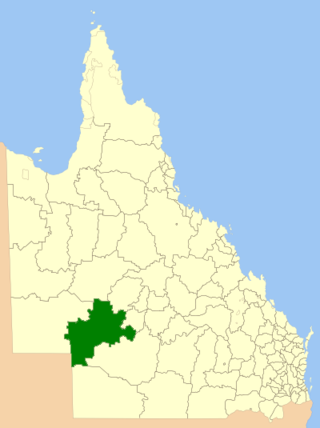Related Research Articles

The Pama–Nyungan languages are the most widespread family of Australian Aboriginal languages, containing 306 out of 400 Aboriginal languages in Australia. The name "Pama–Nyungan" is a merism: it is derived from the two end-points of the range, the Pama languages of northeast Australia and the Nyungan languages of southwest Australia.
The Wilson River language, also known as "Modern" Wankumara, is an Australian Aboriginal language of the Karnic family. It was spoken by several peoples along the Wilson River in Queensland. Of these, the Wanggumara (Wangkumara) and Galali may have migrated from the Bulloo River and abandoned their language when they arrived.

Macro-Pama-Nyungan is an umbrella term used to refer to a proposed Indigenous Australian language family. It was coined by the Australian linguist Nicholas Evans in his 1996 book Archaeology and linguistics: Aboriginal Australia in global perspective, co-authored by Patrick McConvell. The term arose from Evans' theory suggesting that two of the largest Indigenous Australian language families share a common origin, and should therefore be classified as a singular language family under "Macro-Pama-Nyungan".

Muruwari is an extinct Australian Aboriginal language of the Muruwari people, an isolate within the Pama–Nyungan family. Poorly attested Barranbinja may have been a dialect. Muruwari means 'to fall (warri) with a fighting club (murru) in one's hand'. The Muruwari language region includes the areas around the Paroo Shire in Queensland and Brewarrina Shire in New South Wales.

The Shire of Barcoo is a local government area in Central West Queensland, Australia.

The Barcaldine Region is a local government area in Central West Queensland, Australia. Established in 2008, it was preceded by three previous local government areas which had existed for over a century.

The Karnic languages are a group of languages of the Pama–Nyungan family. According to Dixon (2002), these are three separate families, but Bowern (2001) establishes regular paradigmatic connections among many of the languages, demonstrating them as a genealogical group. Bowern classifies them as follows:
Bidjara, also spelt Bidyara or Pitjara, is an Australian Aboriginal language. In 1980, it was spoken by 20 elders in Queensland between the towns of Tambo and Augathella, or the Warrego and Langlo Rivers. There are many dialects of the language, including Gayiri and Gunggari. Some of them are being revitalised and are being taught in local schools in the region. The various dialects are not all confirmed or agreed by linguists.

Maran or Maric is an extinct branch of the Pama–Nyungan family of Australian languages formerly spoken throughout much of Queensland by many of the Murri peoples. The well attested Maric languages are clearly related; however, many languages of the area became extinct before much could be documented of them, and their classification is uncertain. The clear Maric languages are:
Wagaya (Wakaya) is an extinct Australian Aboriginal language of Queensland. Yindjilandji (Indjilandji) may have been a separate language. The linguist Gavan Breen recorded two dialects of the language, an Eastern and a Western variety, incorporating their description in his 1974 grammar.
Wanggamala, also spelt Wanggamanha, Wangkamahdla, Wangkamadla, Wangkamanha, Wangkamana, Wonkamala, Wongkamala, Wonkamudla, and other variants, is an extinct Australian Aboriginal language of the Pama–Nyungan family, previously spoken in the Northern Territory around Hay River and to the south of the Andegerebinha-speaking area.
Yandruwandha is an Australian Aboriginal language of the Pama–Nyungan family. Yawarawarga is considered a dialect by Dixon (2002), a closely related language by Bowern (2001). It is also known as Yawarrawarrka,Yawarawarka, Yawarawarga, Yawarawarka, Jauraworka, and Jawarawarka).
Mithaka is an extinct Australian Aboriginal language in the Barcoo Shire of Western Queensland spoken by the Mitaka people.
Badjiri is an extinct Aboriginal Australian language once spoken by the Badjiri people of southern Queensland.
Guwa, also spelt Goa, Koa, and other variants, is an extinct and nearly unattested Australian Aboriginal language of Queensland spoken by the Koa people. It was apparently close to Yanda.
Bindal is an extinct Australian Aboriginal language of North Queensland. The Bindal language region included the area from Cape Cleveland extending south towards Ayr and the mouth of the Burdekin River, encompassing the landscape within the boundaries of the Townsville City Council and Burdekin Shire Council.
Pirriya is an extinct and unclassified Australian Aboriginal language. It was spoken by the Bidia people of the western and central western Queensland, including Barcoo Shire, Whitula Creek, Cooper Creek, and Jundah.
The Grey Range is a low-lying range of hills located in the Australian states of Queensland and New South Wales. The range extends from the west of Blackall of Central West Queensland in the north to Tibooburra in the far west of New South Wales in the south.
The Badjiri people, also written Budjari or Badyidi, are an Australian Aboriginal people of just north of the Paroo River, close to the southern border of Queensland.
The Gunggari are an Aboriginal Australian tribe of southern Queensland. The traditional land of the Gunggari centres on the Maranoa River and overlaps with the land of the surrounding Mandandanji, Kooma, Kunja, Margany, Dharawala, Bidjara and Nguri peoples. They are to be distinguished from the Kuungkari, who also border Dharawala country.
References
- 1 2 L38 Kungkari at the Australian Indigenous Languages Database, Australian Institute of Aboriginal and Torres Strait Islander Studies
- ↑
 This Wikipedia article incorporates text from Kuungkari published by the State Library of Queensland under CC BY licence , accessed on 25 May 2022.
This Wikipedia article incorporates text from Kuungkari published by the State Library of Queensland under CC BY licence , accessed on 25 May 2022. - 1 2 Bowern, Claire (2001). "Karnic classification revisited". In J Simpson; et al. (eds.). Forty years on. Canberra Pacific Linguistics. pp. 245–260. Archived from the original on 3 November 2021.
- ↑ Wafer, Jim; Lissarrague, Amanda (2008). A Handbook of Aboriginal Languages of New South Wales and the Australian Capital Territory. Muurrbay Aboriginal Language & Culture Co-operative.
- 1 2 Breen, Gavan (1990). Salvage studies of Western Queensland Aboriginal languages (PDF). Pacific Linguistics B-105. Canberra: Pacific Linguistics.